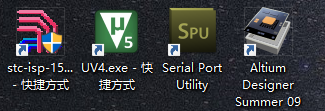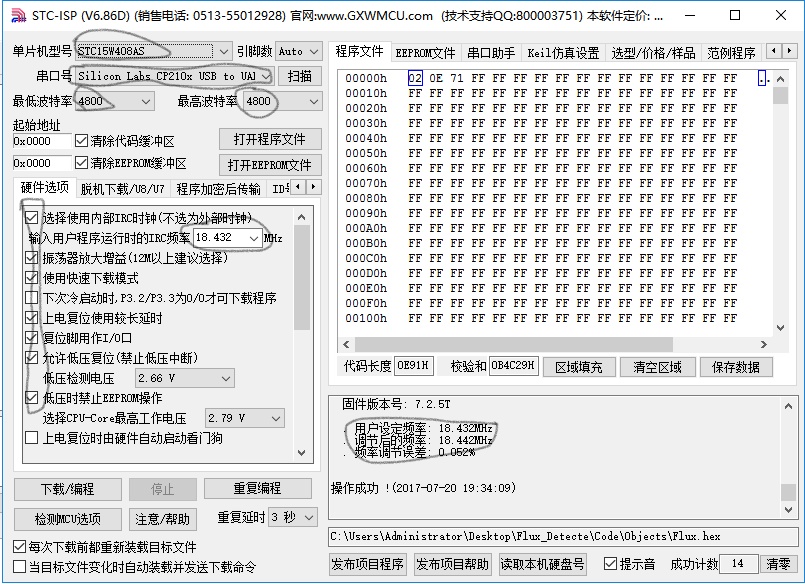第一步:搭建开发环境

安装最新版本的STC_ISP程序烧录软件,链接:http://pan.baidu.com/s/1slLPnOD 密码:6bov
安装keil C51的51系列单片机集成IDE软件,链接:https://www.keil.com/c51/demo/eval/c51.htm
安装串口程序,链接:http://rj.baidu.com/soft/detail/27520.html?ald
安装Altium Designer,链接:http://www.mr-wu.cn/altium-designer-16-ad16-full-crack-baidu-pan-share/
安装CH340的驱动程序,链接:http://pan.baidu.com/s/1nvG7Mlz 密码:b0ka
第二步:绘制完整的PCB版图


手工焊好的洞洞板(注意这里的问题:串口的电源不要给芯片供电哟~): 原件清单:



第三部:编写程序
main.c主程序:
1 #include <STC15W.h> 2 #include <intrins.h> 3 #include <BandGap.H> 4 #include "USART.h" 5 6 void main (void) 7 { 8 uint ADC_Res=0; 9 int i = 0; 10 float Voltage = 0.0; 11 12 Delay20ms(); 13 InitADC(); 14 Usart1_init(); 15 P1n_standard(0); 16 SendString("STC15W408AS\r\nFlux Detect!\r\n"); 17 while (1) 18 { 19 //P10 = 0; 20 //delay_500ms(); 21 for(i=0;i<10;i++) 22 { 23 ADC_Res += GetADCResult(1); 24 Delay20ms(); 25 } 26 //P10 = 1; 27 delay_s(30); 28 ADC_Res = ADC_Res/30; 29 Voltage = ((float)ADC_Res)/1024.0*5.0; 30 SendNumber(Voltage); 31 ADC_Res = 0; 32 } 33 }
STC15W头文件上传到了我的博客园文件盘当中:https://files.cnblogs.com/files/uestc-mm/STC15W.rar
ADC模块程序:

1 #include <STC15W.h> 2 #include <intrins.h> 3 4 #define uchar unsigned char 5 #define uint unsigned int 6 unsigned int v; 7 //ADCÏà¹ØÉ趨²ÎÊý 8 #define ADC_POWER 0x80 //ADCµçÔ´¿ØÖÆλ 9 #define ADC_FLAG 0x10 //ADCÍê³É±êÖ¾ 10 #define ADC_START 0x08 //ADCÆðʼ¿ØÖÆλ 11 #define ADC_SPEEDLL 0x00 //540¸öʱÖÓ 12 #define ADC_SPEEDL 0x20 //360¸öʱÖÓ 13 #define ADC_SPEEDH 0x40 //180¸öʱÖÓ 14 #define ADC_SPEEDHH 0x60 //90¸öʱÖÓ 15 16 #define ID_ADDR_ROM 0x1ff7 //8K³ÌÐò¿Õ¼äµÄMCU 17 18 void Delay20ms() //@12.000MHz 19 { 20 unsigned char i, j, k; 21 22 _nop_(); 23 _nop_(); 24 i = 1; 25 j = 234; 26 k = 113; 27 do 28 { 29 do 30 { 31 while (--k); 32 } while (--j); 33 } while (--i); 34 } 35 36 void delay_500ms(void) 37 { 38 int i=37; 39 for(;i>0;i--) 40 { 41 Delay20ms(); 42 } 43 } 44 45 void delay_s(char N) 46 { 47 char i=0; 48 for(i=0;i<N;i++) 49 { 50 delay_500ms(); 51 delay_500ms(); 52 } 53 } 54 /*---------------------------- 55 ³õʼ»¯ADC 56 ----------------------------*/ 57 void InitADC() 58 { 59 P1ASF = 0x02; //ÉèÖÃP1¿ÚΪAD¿Ú P1.1½Ó¿ÚΪADCÊäÈë½Ó¿Ú 60 ADC_RES = 0; //Çå³ý½á¹û¼Ä´æÆ÷ 61 ADC_CONTR = ADC_POWER | ADC_SPEEDLL; 62 Delay20ms(); 63 } 64 /*---------------------------- 65 ¶ÁÈ¡ADC½á¹û 66 ----------------------------*/ 67 uint GetADCResult(uchar ch) 68 { 69 uint ADC_10BIT_RES; 70 ADC_CONTR = ADC_POWER | ADC_SPEEDLL | ch | ADC_START; 71 _nop_(); //µÈ´ý4¸öNOP 72 _nop_(); 73 _nop_(); 74 _nop_(); 75 while (!(ADC_CONTR & ADC_FLAG));//µÈ´ýADCת»»Íê³É 76 ADC_CONTR &= ~ADC_FLAG; //¹Ø±Õ ADC 77 ADC_10BIT_RES=ADC_RES; //µÃµ½¸ß8λ 78 ADC_10BIT_RES<<=2; 79 ADC_10BIT_RES+=ADC_RESL; //µÃµ½µÍ2λ 80 return ADC_10BIT_RES; //·µ»ØADC½á¹û 81 82 } 83 84 /*---------------------------- 85 ·¢ËÍADC½á¹û 86 ----------------------------*/ 87 void ShowResult(uchar ch) 88 { 89 uint adc_res10,//²âÁ¿É趨ͨµÀadcÖµ 90 bandgap, //bandgapÔ¤´¢´æУ׼ֵ£¬µ¥Î»ºÁ·ü 91 adc_9gallery_res; //²âÁ¿µÚ¾ÅͨµÀ£¨bandgap£©Öµ 92 float power_voltage, //ϵͳ¹©µçµçѹ£¬µ¥Î»ºÁ·ü 93 ADC_voltage; //É趨ͨµÀµçѹֵ£¬µ¥Î»ºÁ·ü 94 95 uchar code *cptr; //¶¨ÒåROM(´úÂë)ÇøÖ¸Õë 96 //uchar idata *iptr;//¶¨ÒåRAM(ÄÚ´æ)ÇøÖ¸Õë 97 98 cptr = ID_ADDR_ROM; //´Ó³ÌÐòÇø¶ÁÈ¡BandGapµçѹֵ(µ¥Î»:ºÁ·ümV) 99 bandgap=*cptr++; 100 bandgap<<=8; 101 bandgap+=*cptr; 102 /*iptr = ID_ADDR_RAM; //´ÓÄÚ´æÇø¶ÁÈ¡BandGapµçѹֵ(µ¥Î»:ºÁ·ümV) 103 bandgap=*iptr++; //Á½ÖÖ·½·¨½á¹ûÒ»Ñù£¬ÉÏÃæµÄ·½·¨ÐèÒªÔÚÏÂÔØʽ¹´Ñ¡"ÔÚIDºÅÇ°Ìí¼ÓÖØÒª²âÊÔ²ÎÊý"Ñ¡Ïî,²Å¿ÉÔÚ³ÌÐòÖлñÈ¡´Ë²ÎÊý 104 bandgap<<=8; //ÏÂÃæµÄ·½·¨²»ÐèÒª 105 bandgap+=*iptr; */ 106 //²âÁ¿É趨ͨµÀadcÖµ 107 ADC_RES = 0; //Çå³ý½á¹û¼Ä´æÆ÷ 108 P1ASF = 0x80; //ÉèÖÃP1¿ÚΪAD¿Ú 109 GetADCResult(ch); 110 GetADCResult(ch); //¶ÁÈý´Î»ñµÃÎȶ¨ 111 adc_res10= GetADCResult(ch); 112 //²âÁ¿µÚ¾ÅͨµÀ£¨bandgap£©Öµ 113 ADC_RES = 0; //Çå³ý½á¹û¼Ä´æÆ÷ 114 P1ASF = 0x00; //ÉèÖöÁµÚ¾ÅͨµÀ 115 GetADCResult(0); //²âbandgapʱ£¬µ÷Óô˺¯ÊýʱͨµÀÊýÖ»ÄÜÌî0 116 GetADCResult(0); //¶ÁÈý´Î»ñµÃÎȶ¨ 117 adc_9gallery_res=GetADCResult(0); 118 //¼ÆËãϵͳ¹©µçµçѹ 119 power_voltage=(float)bandgap*1024/adc_9gallery_res; 120 //¼ÆËãADCͨµÀ²âµÃµçѹֵ 121 ADC_voltage=(float)bandgap*adc_res10/adc_9gallery_res; 122 v=ADC_voltage; 123 v=v*2; 124 }
USART模块程序:

1 /* 2 3 SBUF: UART1 uses register SBUF (address:99H) to hold both the received and transmitted data passing through pins RxD and TxD.all have two in the chip, one for transmit and the other for receive(OK) 4 5 PCON&SCON:Serial port 1 of STC15 series has two control registers: Serial port control register (SCON) and PCONwhich used to select Baud-Rate 6 SCON:SM0 SM1 Mode BaudRate 7 0 1 1 (T1 or T2)/4 (OK) 8 0 0 0 SYSclk/12 9 PCON: 10 B7-SMOD 11 0 : Disable double Baud rate of the UART(OK) 12 1 : Enable double Baud rate of the UART in mode 1,2,or 3. 13 B6-SMOD0 14 0 : SCON.7 is SM0 function(OK) 15 1 : SCON.7 is FE function. Note that FE will be set after a frame error regardless of the state of SMOD0. 16 17 AUXR: 18 B6-T1x12:Timer 1 clock source bit 19 0 : The clock source of Timer 1 is SYSclk/12. It will compatible to the traditional 8051 MCU 20 1 : The clock source of Timer 1 is SYSclk/1. It will drive the T0 faster than a traditional 8051 MCUIf T1 is used as the baud-rate generator of UART1, T1x12 will decide whether UART1 is 1T or 12T.(OK) 21 B0 - S1ST2 : the control bit that UART1 select Timer 2 as its baud-rate generator. 22 0 : Select Timer 1 as the baud-rate generator of UART1(OK) 23 1 : Select Timer 2 as the baud-rate generator of UART1. Timer 1 is released to use in other functions 24 25 IE: 26 B7-EA : disables all interrupts. 27 0 : no interrupt will be acknowledged. 28 1 : each interrupt source is individually enabled or disabled by setting or clearing its enable bit.(OK) 29 B4-ES : Serial port 1(UART1) interrupt enable bit. 30 0 : Serial port 1(UART1) interrupt would be diabled. 31 1 : Serial port 1(UART1) interrupt would be enabled.(OK) 32 33 Timer1 Configuration£º 34 #define Timer1_Load(n) TH1 = (n)/256,TL1 = (n)%256 Use this sentence to set the T1.So we need to calculate the buad_rate we need£¡ 35 36 37 ×ÛºÏÉÏÊöµÄ¼Ä´æÆ÷µÄÅäÖã¬ÎÒÃǽ«Ñ¡ÔñTimer1À´²úÉúUSART1µÄ²¨ÌØÂʵÄʱÖÓÔ´£¬ÎÒÃÇÑ¡ÔñµÄSerial PortµÄģʽMode=1,µ±Êý¾Ý´«ÊäÍê³Éʱ»á²úÉúÖжϣ¬ 38 ÎÒÃÇ¿ÉÒÔͨ¹ý¼ì²éÖжÏÏòÁ¿TI(SCON-B1)µÄÖµÀ´ÅжÏÊý¾ÝµÄ´«ÊäÊÇ·ñÍê³É£¬Íê³ÉÔòΪ1£¬Î´Íê³ÉÔòΪ0£ºwhile(TI == 0); --> TI = 0;(²»ÒªÍü¼ÇÇåÁã) 39 40 ÄÇô²¨ÌØÂʵļÆËãÈçÏ£ºBuad_Rate = T1/4 41 É趨µÄTimer1ʱÖÓÈçÏ£ºTime_Clk = SYSclk/1 42 */ 43 #include <STC15W.h> 44 #include <intrins.h> 45 46 typedef unsigned char BYTE; 47 typedef unsigned int WORD; 48 49 #define FOSC 18432000L //System frequency 18.432MHz 50 #define BAUD 115200 //UART1 baud-rate 51 52 void Usart1_init(void); 53 void SendData(BYTE dat); 54 void SendString(char *s); 55 56 void Usart1_init(void) 57 { 58 SCON = (SCON & 0x3f) | 0x40; //Ñ¡Ôñusart1µÄmodeΪ1 59 S1_USE_P30P31(); 60 Timer2_1T(); //The clock source of Timer 2 is SYSclk/1. 61 Timer2_AsTimer(); // TMOD &= ~(1<<6) ¶¨Ê±Æ÷1ÓÃ×ö¶¨Ê±Æ÷ 62 S1_BRT_UseTimer2(); //Select Timer 1 as the baud-rate generator 63 T2L = (65536 - (FOSC/4/BAUD)); //Set the preload value 64 T2H = (65536 - (FOSC/4/BAUD))>>8; 65 EA = 1; 66 ES = 1; 67 Timer2_Run(); // Æô¶¯¶¨Ê±Æ÷1 68 } 69 70 void SendData(BYTE dat) 71 { 72 SBUF = dat; 73 while(!TI); 74 TI = 0; 75 } 76 77 void SendString(char *s) 78 { 79 while (*s) 80 { 81 SendData(*s++); 82 } 83 } 84 85 void SendNumber(float num) 86 { 87 int a,b; 88 a = (int)num; 89 b = (int)((num-a)*10); 90 SendData((unsigned char)(a+48)); 91 SendData('.'); 92 SendData((unsigned char)(b+48)); 93 SendData('\n'); 94 }
第五步:下载程序
 我用的是CP2102的驱动芯片
我用的是CP2102的驱动芯片
这里是我的选择的设置

注:在这过程中遇到的问题罗列如下
1 下载程序出现BUG:
STC-ISP提示“调整频率无响应”,下载失败的字样,按照官网的步骤意义排查,还是没能解决问题,最后看到宏晶官网的重要提示(参考网站:http://www.stcisp.com/q_and_a_stcisp.html):
一、(特别注意:烧写点击编程键后,单片机必须断电进行冷启动!)
二、部分USB转串口线会通过RxD/TxD引脚对单片机供电,导致下载时不能彻底断电。可在单片机的TxD引脚串一个二极管(接正极,如图),使单片机可彻底断电冷启动。(注:若USB转串口芯片共板,不要对USB芯片断电,否则USB转换的串口会消失)
三、供电部分最好不要用串口的VCC和GND来连接,直接用单独的电源就好。
2 Keil C51的集成IDE中未能找到STC15W408AS的解决办法(参考网站:http://www.stcmicro.com/wtjd.html):
*STC 单片机应使用何种编译器/汇编器?
1任何老的编译器/汇编器都可以支持,流行用Keil C51
2.把STC单片机,当成Intel的8052/87C52/87C54/87C58,Philips的P87C52/P87C54/P87C58就可以了
3.如果要用到扩展的专用特殊功能寄存器,直接对该地址单元设置就行了,当然先声明特殊功能寄存器的地址较好
*Keil C51编译器中无STC单片机型号,怎么办?
1.把STC单片机,当成Intel的8052/87C52/87C54/87C58,Philips的P87C52/P87C54/P87C58就可以了
2.也可安装STC仿真器的驱动程序,这样就看到型号了.
实验结果:





 浙公网安备 33010602011771号
浙公网安备 33010602011771号